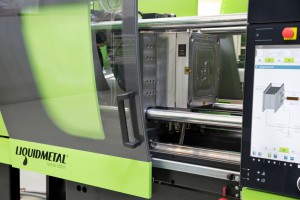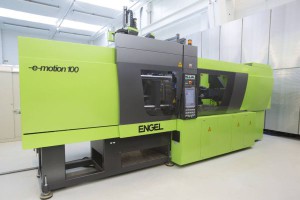Today we can mould a new class of metal alloys as if they were a thermoplastic material. Applications can be manifold.
A new innovative and revolutionary technology has recently approached the market, permitting the injection moulding of metal alloys. It is a process developed by Liquidmetal Technologies Inc., American enterprise that has developed metal alloys with highly innovative physical and mechanical properties, and by ENGEL, Austrian giant operating in the production of injection presses on a world scale.
An extraordinary innovation
To understand more about that, we involved Maurizio Passalacqua, Managing Director of ENGEL Italia S.r.l. (Vimercate, MB), to whom we asked to explain us in detail in what this new technology consists.
«The name “Liquidmetal” – starts Passalacqua – indicates a completely new class of material, also called “glassy metals”, characterized by extraordinary mechanical properties. They are zirconium alloys, marketed by Liquidmetal Technologies Inc. in Rancho Santa Margarita, in California, United States, and produced by Materion in Ohio, which can be used to produce metal parts by injection moulding.
This is a real revolution, since we know that the injection moulding allows manufacturing exclusively thermoplastic material products. At least until now. Passalacqua goes on: «ENGEL not only has developed an injection press able to process this type of alloys efficiently but it also holds the exclusive licence for the manufacturing of this type of machines and therefore represents the only supplier in the world authorized to offer integrated system solutions for the injection moulding of Liquidmetal alloys».
What properties have the pieces implemented with this technology? «The items manufactured with Liquidmetal alloys have an amorphous structure, that is to say non-crystalline, which determines their extraordinary properties. These components are highly resistant but, at the same time, they feature high elasticity allowing them to recover the initial shape rapidly in case of deformation. The steel elasticity, for instance, is equal to 0.2%, and the one of titanium corresponds to 1%, while the products made with Liquidmetal alloys reach the 2% elasticity value. Besides, those materials stand out for their low specific weight and their extraordinary resistance to corrosion. This allows developing products provided with absolutely innovative characteristics, which can be injection-moulded at really appealing costs and with excellent surface finishes ».
What characteristics has the injection press by Engel that moulds Liquidmetal alloys? «It is a press developed according to our tested series of electrical ENGEL e-motion machines, from which it differs for the injection group. Liquidmetal alloys are available under the form of ingots, obtained by cutting a round bar. These ingots are automatically introduced, with an ENGEL Viper robot, in the press melting chamber where the material is heated up to about 1,000 degrees by means of a magnetic induction system and under highly controlled vacuum conditions. Instead of the standard plasticizing screw, the machine is equipped with a piston that provides for injecting the melted metal alloy into a refrigerated mould. The cooling, which occurs very quickly in absence of oxygen, causes the formation of an amorphous structure. The finished products are finally removed by ENGEL viper robot equipping the press, while the riser can be eliminated with the aid of a water jet cutting machine or by a mechanical cutter ».
We are speaking, in other words, of moulding metal: besides Liquidmetal alloys, is it possible to use other metal alloys? «No, at present. But in principle we might hypothesize the development of similar applications in the future».
What are the main advantages and disadvantages in comparison with conventional technologies?
«In NC machining, the single components are drawn from metal blocks by milling and drilling. In this way, it is possible to implement precision parts with complex three-dimensional geometries and high-quality surface finishes but, compared to the injection moulding, it needs long times and high costs. The MIM process too is based on the injection moulding technology but the machined materials are not metal alloys but metal powders and plastic. The plastic material is heat-removed after the injection moulding, and to obtain the finished item, before it is necessary to subject the component to a sintering process: all additional machining operations that can require very long times, depending on the wall thickness. Moreover, the surface finish quality that we attain by sintering is lower than that granted by the Liquidmetal process. The Liquidmetal technology eliminates all these drawbacks and allows the manufacturing of highly efficient and low-cost precision components, ready to use and provided with surface finishes that were unfeasible in the past. Cycle times range from two to three minutes, much shorter than the machining times required by the Numerical Control technology. Another advantage is represented by the absence of wastes because, with Liquidmetal, risers are recycled and reintroduced into the process chain. The main benefit is the “net shape forming” that is to say the possibility of producing finished parts, ready to use as if they were plastic components ».
Passalacqua specifies: «Liquidmetal costs 100 Euros euro per kilo. To implement the productive process, it is necessary a riser that must be recycled, with a “proprietary” process, by Materion in USA. We think anyway that soon a structure for the riser recycling will be available in Europe, too».

Liquidmetal ingots are fed by a vibrating unit and then introduced into the melting chamber of the press by ENGEL viper robot.
A world of possibilities at the horizon
What sectors and what category of subcontractors can use that solution or have they already used it? «The technology, in its current form, is in its early phases and it was presented to the public during the workshop held by ENGEL, in Austria, in June 2015, with a mould produced by Saga from Cadoneghe that already experienced in the past this type of technology, even if with different processing equipment. Concerning outlet sectors, we foresee great potentialities in the medical technology sector: for this reason, on the occasion of ENGEL convention, we showed the implementation of medical pliers to visitors». Actually, LM105 grade of Liquidmetal family proved to be optimal for biomedical applications, since haemocompatible, non-sensitizing, non-irritating, neither toxic nor cytotoxic. Passalacqua adds: «Thanks to such characteristics, the opportunities extend also to endoprostheses, like those for the hip, and stents. We believe that most applications will address the medical field».
Can you imagine developments in other application ambits, too? «Yes certainly. Thanks to the excellent mechanical properties of the material, it is possible to implement very sturdy components with very thin walls; such specifications allow the manufacturing of components undergoing high mechanical stresses, for instance in sports ambit. Liquidmetal technology was used to produce the watches Omega Seamaster Planet Ocean and Breguet «Reveil Musical», and the Swiss Swatch has recently bought the licence. Moreover: we know that Apple has acquired the exclusive licence for the “consumer electronics” sector. In short, potential applications can be endless; we can implement sporting structures, products for the automotive, aerospace and electronics industry and so on»

Approximately 15 mm-long part implemented with Liquidmetal, drawn from the mould in “finished” form.
Are there any implementation constraints? «Liquidmetal defines its technology, as already said, “net shape forming”, in other words it allows the injection of any type of finished piece, as if it was a plastic part. The limit is represented by the weight: the maximum limit is currently included between 80 and 100 grams».
Is it possible to make moulds with this technology? «In virtue of the weight constraint just mentioned, it is not possible to manufacture moulds. Liquidmetal is however proceeding to qualify mould makers able to make moulds for the production of parts with their own technology».
Is it an appealing technology only for moulding industries? «We believe that the ideal producer of Liquidmetal parts is a moulding firm able to rely on the mould and on the moulding technology simultaneously. The mould must be manufactured with steels resistant to heat and to abrasion and it requires shorter maintenance intervals than a mould for plastic».
How is it possible to obtain a Liquidmetal licence? «Liquidmetal Technologies grants licences while ENGEL provides the authorized partners with the necessary machines. Since moulds must satisfy a series of severe requisites, also the mould maker must have a suitable certification. Liquidmetal Technologies contacts the authorized mould makers and provides them with the necessary support in design and manufacturing phase. Our partner for the mould making for ENGEL 2015 symposium, for instance, as already said, was the Padua Saga, while the Liquidmetal alloy was supplied by Materion, headquartered at Mayfield Heights, in Ohio, United States».
What a pair!
Liquidmetal is the trade name of a family of amorphous metal alloys developed by a research group of the California Institute of Technology, and marketed by the Californian company Liquidmetal Technologies. The American enterprise controls the intellectual property rights of over 70 patents in the United States, thanks to which it develops new products and technologies that are drastically changing the way of implementing technical items.
ENGEL, even if it is a family-owned business, is a group that employs about 4800 workers, counts 9 production sites as well as branches and representations worldwide. Since 1945, year of its foundation, ENGEL has aimed at the highest quality of its products and at the full customer satisfaction.
Extraordinary properties
The pieces produced with Liquidmetal can reach the maximum weight of 80-100 grams, the size of 100 mm and thicknesses included between 0.6 and 4 mm. Parts can be produced with ± 0.025 millimetre dimensional tolerance, with moulds featuring 64 cavities maximum. The products made with such alloys assure high hardness, high elasticity and high resistance to corrosion. Besides, they can be welded without damaging the amorphous structure in the melting zone (the effects of the welding with different materials are still under study).
Do not miss this opportunity
Saga S.p.A. from Cadoneghe (PD) took part in the technological workshop organized by ENGEL last June, implementing a mould with which some medical pliers were made with Liquidmetal metal alloys. The demo was impressive for the attending engineers, also due to the process quality and the attained parts.
Giancarlo Peruzzo, sales manager of the company, goes into detail: «The technology developed by Liquidmetal and ENGEL is very interesting, besides we already knew it through a joint venture cooperation with Liquidmetal itself from 2006 to 2012. In the past, we had developed and produced components for the market, using, however, certainly unsuitable machinery and machining processes for this ”special” technology. Today, thanks to the new e-motion 110 press by the Austrian enterprise and the production techniques of a business of international relevance like Materion, moulding Liquidmetal metal alloys has become “industrially” feasible. Moreover, with higher qualities compared to die casting and sintering». The technology has not a concrete market development, yet, nevertheless it relies on a great potential. «Certainly – adds Peruzzo –, we should just consider the importance of the companies that are acquiring use rights: Apple in Cupertino above all. That is the reason why we, paying constant attention to moulding technologies, believe that we should not miss this opportunity».
Cupertino “Apple” smells the good deal
The foreign press, and in particular the American one, is strongly highlighting the investments that Apple Inc. is lavishing in the sector of metal alloy injection moulding, thanks to the exclusive licence released by Liquidmetal. The target consists in manufacturing components for the electronic industry, for instance of iPhone, iPad, etc., subtler and subtler but more resistant than in the past, characterized by high precision and surface quality, while reducing production costs, too.





